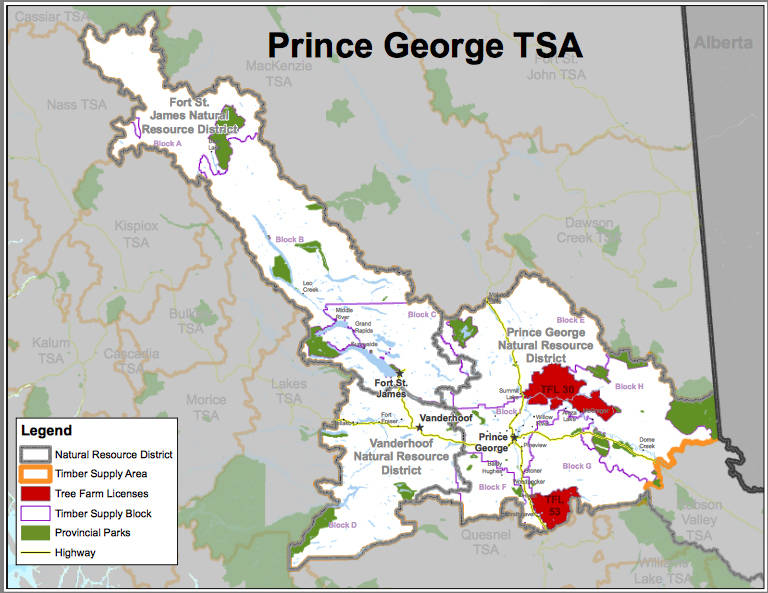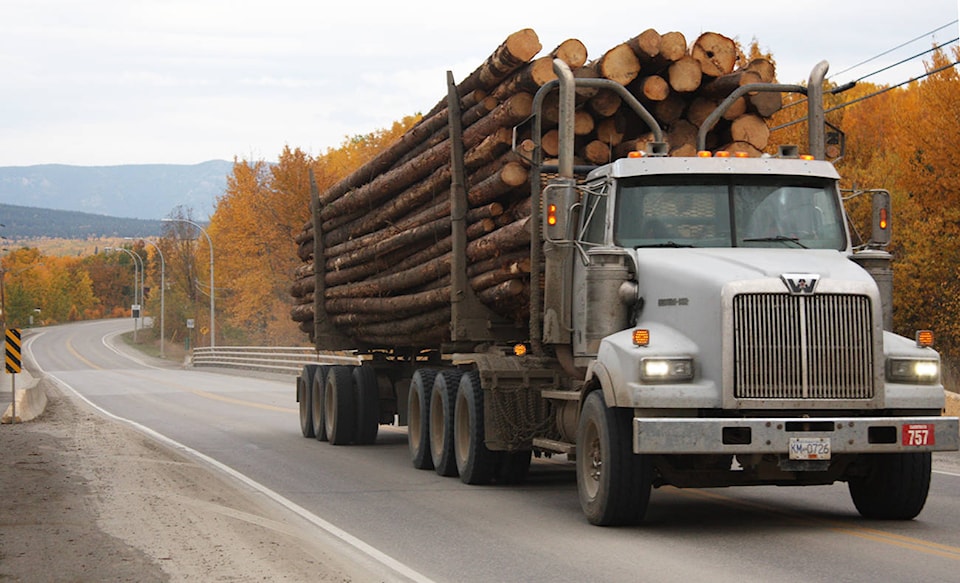VICTORIA- Effective immediately, Wed. Oct. 11, the new allowable annual cut (AAC) for the Prince George Timber Supply Area (TSA) is set at 8,350,000 cubic metres per year for the first five years, and 7,350,000 cubic metres for the following five years, chief forester Diane Nicholls announced today.
Currently, there are 13 lumber mills, three pulp mills, one utility mill, four pellet operations, two cogeneration facilities and a bioenergy facility operating in this timber supply area. Major communities include Prince George, Vanderhoof, Fort St. James and Fraser Lake.
As per the BC government press release, the new cut level includes three partitions (see map):
- A maximum of 1.5 million cubic metres per year is attributed to supply blocks A and B.
- A maximum of 6.1 million cubic metres per year is attributed to the remaining supply blocks (and reduced to 5. 1 million cubic metres in October 2022), of which 62,000 cubic metres per year is attributed to deciduous-leading stands.
- A maximum of 750,000 cubic metres per year is attributed to bioenergy stands.
With the partitions, in the first five years harvesting will focus on the salvage of stands damaged by spruce-, pine- and/or balsam-bark beetle, as well as wildfire. After that time, the chief forester may apply a partition to account for the recovery of dead fibre in spruce-beetle impacted stands.
This new cut level represents a 33% decrease from the allowable annual cut of 12.5 million cubic metres set in 2011, which had been temporarily increased to harvest mountain pine beetle killed timber. However, the average annual harvest over the past five years was 9.1 million cubic metres per year, so the reduction is approximately 8%.
The Prince George TSA covers about 8 million hectares in the north-central Interior of the province and is one of the province’s largest management units. Approximately 3 million hectares of the total TSA land base is considered available for timber harvesting. The leading tree species are lodgepole pine, spruce and subalpine fir.
Reasons for the decision
The chief forester’s determination takes into consideration winter range for ungulates, as well as habitat requirements for other wildlife, which are managed through wildlife habitat areas.
“After reviewing all relevant factors on timber and non-timber resources, and taking into consideration First Nations’ interests in the Prince George TSA, I am satisfied that the new AAC will ease the transition to a lower mid-term timber supply and allow more time for local and regional economies to adjust,” said Nicholls.
The chief forester’s allowable annual cut determination is an independent, professional judgment based on information ranging from technical forestry reports, First Nations and public input to the government’s social and economic goals.
Under the Forest Act, the chief forester must determine the allowable annual cut in each of the province’s 37 timber supply areas and 34 tree farm licences at least once every 10 years.
She summarized the factors which influenced her understanding of available timber supply. These factors include:
- modifications to current practice;
- the influence of the spruce beetle outbreak;
- the remaining salvage opportunities from mountain pine beetle-impacted stands;
- potential impacts of timber harvest on forest values other than timber, notably wildlife;
- socio-economic implications of reducing timber supply;
- and potential impacts to Aboriginal Interests and treaty rights.
The full document explaining the allowable annual cut determination is available from the Prince George Natural Resource District office, the Stuart Nechako Natural Resource District offices or online at: http://ow.ly/g5Wv30fgYeS
P.G. Timber Supply Area
The Prince George timber supply area (TSA) is in British Columbia’s north-central interior and covers about 7.97 million hectares. It includes the City of Prince George, the towns of Vanderhoof and Fort St. James and several smaller communities such as Fraser Lake.
The Prince George TSA stretches from near the Alberta border in the southeast to Tweedsmuir Provincial Park in the southwest and Spatsizi Plateau Wilderness Park in the northwest.
The TSA is part of the Omineca Natural Resource Region and is administered by the Prince George Natural Resource District and the Stuart Nechako Natural Resource District (previously known as the Fort St. James Natural Resource District and Vanderhoof Natural Resource District).
The last AAC was set in 2011. Generally, a new AAC is set at least once every 10 years.
- files from press release by Ministry of Forests, Lands, Natural Resource Operations and Rural Development

